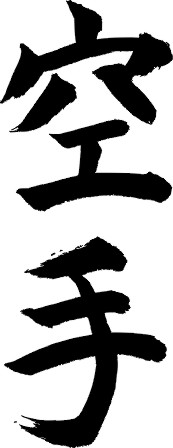![]()
|
|
|
|
Karate You probably think of some old Japanese man when you think of Karate. Well, here is a picture of the founder of "Shotokan" Karate. The style I have studied & practiced since 1984. Karate-do is a martial art for the development of character through training, so that the karate-ka (the karate student) can mount any obstacle, tangible or intangible. It is an empty-handed art of self-defense in which the body itself is used as a weapon through techniques of punching, kicking, striking, and blocking. Of primary importance in the study of karate are form, balance, "centered-ness", power, speed, kime (concentration of power), rhythm and timing. At our school we will do:
 Traditional
Karate evolved in Japan in the early 18th century as a self-defense
martial art called "Budo." Through training, the students of
Traditional Karate strengthen physical and mental skills while developing
self-control. Further, students learn to understand the physical and
mental condition of their opponents, and thereby avoid fighting --the ultimate
goal of karate. Only by avoiding fighting, can one truly win. Traditional
Karate evolved in Japan in the early 18th century as a self-defense
martial art called "Budo." Through training, the students of
Traditional Karate strengthen physical and mental skills while developing
self-control. Further, students learn to understand the physical and
mental condition of their opponents, and thereby avoid fighting --the ultimate
goal of karate. Only by avoiding fighting, can one truly win.In the beginning, Karate developed as a weaponless form of self-defense which utilized effective total body power. First, the special skills were highly developed, followed by technical organization. The formation of karate as a martial art followed. The physical and mental benefits of this art form have been recognized
worldwide. Through physical training, a student learns that emotions control the
physical body. Karate is the mastering of the body, the mind, and the emotions.
It creates self-confidence in oneís ability to stop an opponent with a single
finishing blow (todome). Such confidence leads to stable emotions. Stable
emotions eliminate negative emotions, to the benefit of physical and
mental health.
Pre-arranged sequences of self-defense techniques known as kata are the nucleus of all traditional Okinawan and Japanese Karate styles. Each kata is a long fight against multiple attackers. There are hundreds of individual kata still practiced by traditional karate systems, some of which are centuries old. Many of these kata originated in China, while others were first developed in Okinawa; or more recently, in mainland Japan. In the last fifty years, as senior masters of traditional styles have relocated to introduce karate around the globe, many styles gradually introduced newer kata in additional to the established roster of older forms. In some cases, these modern forms include individual sequences borrowed from older kata for purposes of self defense versatility. In other cases, these kata have been introduced for interstyle competiton, or to diversify the way sensei teach basic techniques to newer students. In spite of the great variety of kata practiced internationally today, it is quite probable that many kata have been lost, and with them, valuable self defense techniques of past martial arts masters. Until the introduction of free-sparring in the 1950ís, kata was universally considered to be the core element of karate training and the most important area of development for karate practitioners. Today, while most of the traditional schools still practice and teach kata, many do so for purposes of competition, necesitating that greater emphasis be placed on the aesthetics of kata as a performance rather than on the self-defense techniques contained within the movements of each form. Shotokanís primary reason for emphasizing kata is to teach the diverse arsenal of self defense techniques and lessons developed by sensei in previous generations. Since there were few written records of karate techniques until this century, we must consider kata to be the living encyclopedia of ancient karate sensei. Kata practice offers many benefits to Shotokan-ka in
addition to self defense. All Shotokan kata require deep, strong stances and
include upper and lower body techniques, providing excellent all-around muscle
development and flexibility. Most kata include techniques on both the left and
right sides, enhancing oneís coordination. Multiple repetitions of kata offer
an excellent cardiovascular workout, with the added benefit of unified mental
and physical coordination. For this reason, kata practice should never be
boring. By definition, kata is the simultanious development of mind and body
working together in harmony--an essential ingredient for effective self-defense.
Kata practice enhances concentration and focus, lessons which carry outside the
dojo into Shotokan-kasí everyday lives. Kata practice allows individuals to
learn and train at their own speeds, and to set personal goals which can be
reached, beaten, and revised. Finally, unlike most other martial arts
activities, kata allows one to practice karate at any time and in any location,
alone or with other people. Some of the characteristics of all traditional karate kata include* :
Proper form, posture and dynamics for power
|
|
|
All material protected by Zandanet©.
|